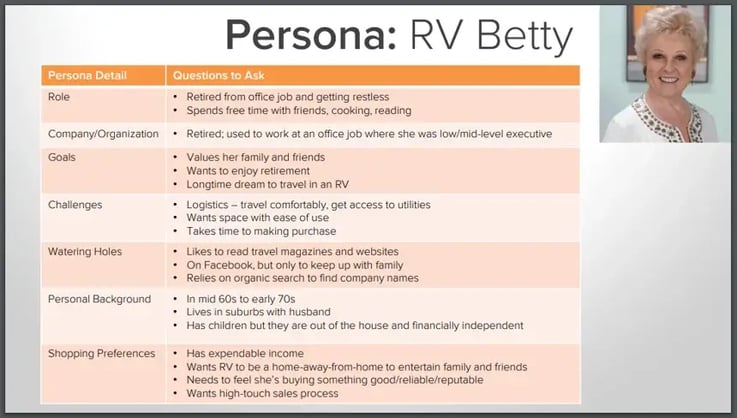4 E-commerce Trends in 2026
What will the biggest e-commerce trends be in 2026? Artificial Intelligence will clearly play a big role. We explore those trends with 4 predictions.

Creating a buyer persona (aka customer persona, marketing persona, customer avatar) is useful for more than just your marketing department. For example, your sales team and customer success department can get a lot of use from having these descriptions at their disposal. In today’s blog, we’ll be looking at what a buyer persona is, why it’s important, and how to create one.
Table of Contents:
A buyer persona is a description of your ideal customer. Though every customer is different, the idea here is to compile the characteristics they have in common and create a description of this "generic ideal customer".
The information you provide will contain some personal descriptors like age, gender and family status, but will also have more professional information like job title, and work challenges. Naturally, you can get into much deeper detail as well by including things like personal background and hobbies, etc. This can really help paint the picture of who your core customer really is.
Depending on your shop, there’s a good chance you have more than one “ideal customer”. It is, therefore, not unusual to have more than one buyer persona for your business. It’s actually fairly common to produce between three and five of these descriptions.

Source: Hubspot
As I mentioned above, a buyer persona can be incredibly helpful for multiple departments of your business.
For content marketers, knowing who your audience is can help guide the topics of your content and the style that you write them in. The concept is very similar to what traditional advertising tries to achieve: speak to your audience in the way that they speak.
You wouldn’t use the same words and phrases to target first-time mothers as you would to target 50+ year-old CEOs, would you? That's why you need to identify who your ideal customer is.
Again, if you have multiple customer groups, then you should create multiple customer personas. Once they are defined, you can use the micro-targeting techniques to personalise your marketing campaigns for your different personas.
With this in mind, having an accessible and well-communicated customer persona can benefit any department that deals directly with your customers, whether it’s marketing, sales or customer support. Basically, any team that deals with customer acquisition and/or retention can do their jobs better with customer personas available to them.
Creating a good buyer persona is all about asking the right questions to the right people. Try to learn about who your best current customers are. Get in touch with your sales department and try to get some insights from them about who tends to make the best customers. Learn about what kind of questions your customers ask, what “scares” them, what pain points they have, etc.
If your sales team has a good relationship with any specific customers, ask them to reach out about whether they can spare some time and answer a few questions for the company.
If you don't have a sales team, then you could also look into your marketing department and see what kind of information you can find there. Connect the ad-clickers to checkouts and figure out what ads are working best and what audience settings you've targeted in order to reach them.

shutterstock/intararit
Though you might be hesitant to reach out to the customers directly, think about the great insights they can provide. If you are clear with them that this isn’t a sales call, but are in fact interested in their opinions in order to improve your products and the customer experience, they very well might be flattered to have been asked for their opinions.
If you’re having trouble getting interviews, then check out your social media followers and see what kind of information you can get from them there. If you’re a brand new business, you might want to look at your biggest competitors’ followers to find any patterns in the most engaged followers.
If you do have your own customers already, you should try to get opinions from both sides of the “happy customer spectrum”. Sure, it’s nice to know why your customers love your company and your products, but knowing what gives them trouble with your product/company/industry can not only help you market to them better, but it can help you improve your products as well.
To find those “bad customers”, scan through your company’s negative reviews, and try reaching out to those customers. They might even be grateful to know you’ve responded to their negative review and that you’re working hard on improving your products for them.
If all else fails, you might even want to consider incentives for opinions. Just like with a focus group, people always respond to an exchange of money (or discounts) for their time.
Now you know who to ask, so let’s talk about what to ask them. The questions you can ask them can be split up into the following categories:
Job/industry
Learning
Personal background
Shopping preferences
With these kinds of questions, you’ll want to gather information about their role, their specific company and about the industry in general. Try to take note of some real quotations from your customers and place it directly in the buyer persona you create. Here are a few examples of some typical questions to ask them:
What is your job title/role?
How is your position’s success measured?
What tools do you use in your job?
What is a typical day like for you?
What industry is your company in?
How big is your company?
What are your (company’s) biggest challenges?
With these “learning” questions, you will try to find out where these people learn new things about their industry or how to improve their work. By researching their answers, you’ll get a better understanding of what topics interest them. Some questions you might ask:
Where do you get new information about the industry and your job?
Which blogs do you read?
Do you attend any industry events?
How old are you?
Are you married? Do you have children?
What are your hobbies?
What level of education have you completed?
Where do you see your professional career going in the future?
With the following questions, you’re going to try to gather information about how and where your customers shop. Here are a few questions you can ask them about their business shopping habits:
What product have you recently purchased for your business?
How did the sale go?
Were you happy with the customer service and the sales approach?
How do you research products and services for your company?
Do you prefer sales calls, e-mails or in-person demonstrations?
Who is the final decision maker when it comes to these purchases?
If you use a special platform for your marketing and sales, there might be a dedicated section in the backend for you to place this information. With Hubspot, for example, this information can be found in the marketing dashboard. Hubspot has offered a free persona template tool to help you get started.
Either way, you’ll want to gather this information and break it down into sections (like the categories of questions mentioned above). It might even help to give them a name (like Marketing Mathew or IT Ivan) and put a photo of this “ideal customer’s” face together with the textual information you’ve gathered.
By literally placing a face and name on this person, it can help you and your coworkers to think about this person as someone real that you are targeting. By remembering that this person probably has children, for example, you might change your writing style to really “speak their language”.
The main idea here is really for this information to be easily available for your different teams to refer to at any point. So, it might sound silly in this digital age, but you might even want to print out this information and post it on the walls of your office.
By knowing who your customer is, how they think, and what challenges they have, you can better target them and address the issues most important to them. Talk to your customers and talk to your teams and paint the most accurate picture you can of your ideal customer(s) and remember that there are real people on the other end of the computer, phone and world and there are always better ways to communicate with them.
03/02/21What will the biggest e-commerce trends be in 2026? Artificial Intelligence will clearly play a big role. We explore those trends with 4 predictions.
SEO is an important tool for e-commerce businesses to bring in new customers. Here are the best tips for your online shop to rank higher in Google.